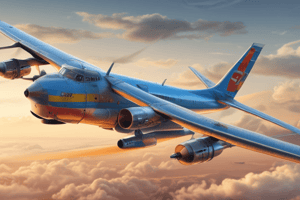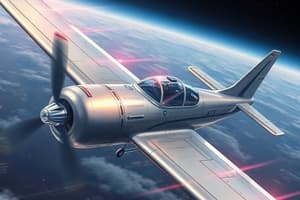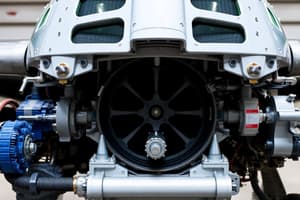Podcast
Questions and Answers
Which of the following is a primary function of the ailerons, elevator, and rudder in an aircraft's flight control system?
Which of the following is a primary function of the ailerons, elevator, and rudder in an aircraft's flight control system?
- Providing supplemental power to the aircraft's electrical systems.
- Enhancing lift and aiding in control without continuous pilot input.
- Regulating air pressure within the hydraulic system.
- Generating roll, pitch, and yaw movements to maneuver the aircraft. (correct)
What is the primary purpose of secondary control surfaces like flaps, spoilers, and trim tabs on an aircraft?
What is the primary purpose of secondary control surfaces like flaps, spoilers, and trim tabs on an aircraft?
- To directly control the engine's power output and fuel consumption.
- To enhance lift, aid in control, and balance without continuous pilot input. (correct)
- To manage the electrical load distribution throughout the aircraft.
- To provide the primary means of controlling the aircraft's direction.
In a fly-by-wire (FBW) system, what components are responsible for processing pilot inputs and sending commands to the actuators?
In a fly-by-wire (FBW) system, what components are responsible for processing pilot inputs and sending commands to the actuators?
- Bleed air valves and pressure regulators.
- Hydraulic lines and pumps.
- Sensors, computers, and digital systems. (correct)
- Direct mechanical linkages.
Which component is NOT a typical part of an aircraft's hydraulic system?
Which component is NOT a typical part of an aircraft's hydraulic system?
What is the purpose of having multiple independent circuits in an aircraft's electrical or hydraulic system?
What is the purpose of having multiple independent circuits in an aircraft's electrical or hydraulic system?
What is the function of the Essential (ESS) Bus in an aircraft's electrical system?
What is the function of the Essential (ESS) Bus in an aircraft's electrical system?
What is the function of transformers and rectifiers within the distribution system of an aircraft's electrical system?
What is the function of transformers and rectifiers within the distribution system of an aircraft's electrical system?
Where does the pneumatic system of an aircraft typically source its air from?
Where does the pneumatic system of an aircraft typically source its air from?
Which of the following is NOT a typical application of the pneumatic system in an aircraft?
Which of the following is NOT a typical application of the pneumatic system in an aircraft?
What is the primary function of fuel jettison in an aircraft's fuel system?
What is the primary function of fuel jettison in an aircraft's fuel system?
What role does the Auxiliary Power Unit (APU) play in an aircraft's operations?
What role does the Auxiliary Power Unit (APU) play in an aircraft's operations?
Which of the following best describes the purpose of an aircraft's anti-ice/de-ice system?
Which of the following best describes the purpose of an aircraft's anti-ice/de-ice system?
What is the main objective of an aircraft's oxygen system?
What is the main objective of an aircraft's oxygen system?
Which of the following is a component of an aircraft's fire protection system?
Which of the following is a component of an aircraft's fire protection system?
What is the function of outflow valves in the cabin pressurization system?
What is the function of outflow valves in the cabin pressurization system?
What mechanical function does the accessory gearbox perform in the power plant (engine system)?
What mechanical function does the accessory gearbox perform in the power plant (engine system)?
What parameters are regulated by a FADEC (Full Authority Digital Engine Control) system?
What parameters are regulated by a FADEC (Full Authority Digital Engine Control) system?
What is the main function of the fuel filter in the fuel system?
What is the main function of the fuel filter in the fuel system?
What is the function of the lubrication and oil system?
What is the function of the lubrication and oil system?
What is the primary purpose of thrust reversers in some aircraft?
What is the primary purpose of thrust reversers in some aircraft?
Flashcards
Primary Control Surfaces Function
Primary Control Surfaces Function
Generate roll, pitch, and yaw movements, to maneuver the aircraft.
Secondary Control Surfaces Function
Secondary Control Surfaces Function
Enhance lift, aid in control, and balance without continuous pilot input.
Fly-by-Wire (FBW) Components
Fly-by-Wire (FBW) Components
Sensors, computers, and digital systems process pilot inputs and send commands to actuators, eliminating direct mechanical linkage.
Auxiliary Power Unit (APU) Functions
Auxiliary Power Unit (APU) Functions
Signup and view all the flashcards
FADEC System Function
FADEC System Function
Signup and view all the flashcards
ESS Bus Main Function
ESS Bus Main Function
Signup and view all the flashcards
Fuel Tanks Function
Fuel Tanks Function
Signup and view all the flashcards
Accessory Gearbox Role
Accessory Gearbox Role
Signup and view all the flashcards
Engine Lubrication System Functions
Engine Lubrication System Functions
Signup and view all the flashcards
Cabin Air Conditioning
Cabin Air Conditioning
Signup and view all the flashcards
Cabin Pressurization
Cabin Pressurization
Signup and view all the flashcards
Fire Protection System Zones
Fire Protection System Zones
Signup and view all the flashcards
Primary Source of Air for Pneumatic System
Primary Source of Air for Pneumatic System
Signup and view all the flashcards
Hydraulic System Circuits
Hydraulic System Circuits
Signup and view all the flashcards
Actuators Types
Actuators Types
Signup and view all the flashcards
Avionics Systems Navigation
Avionics Systems Navigation
Signup and view all the flashcards
Power Sources
Power Sources
Signup and view all the flashcards
Study Notes
Flight Control System (FCS)
- Primary Control Surfaces include ailerons, elevator, and rudder
- Primary control surfaces generate roll, pitch, and yaw moments to maneuver the aircraft
- Secondary Control Surfaces include flaps, spoilers, and trim tabs
- Secondary Control Surfaces enhance lift, aid in control and balance with continuous pilot input
- Input Devices encompass sidesticks, yokes, and rudder pedals
- Actuators are hydraulic or electric and are used to move the control surfaces
- Fly-by-Wire (FBW) Components use sensors, computers, and digital systems to process pilot inputs and send commands to actuators, eliminating direct mechanical linkage
Hydraulic System
- Components include hydraulic pumps (typically engine-driven or electric), reservoirs, accumulators, valves, and actuators
- Power Sources include engine-driven pumps, electric pumps, Power Transfer Unit (PTU), and Ram Air Turbine (RAT)
- Circuits consist of multiple independent circuits (e.g., Green, Blue, and Yellow in A320) to ensure redundancy and safety
Electrical System
- Power Sources are generators (engine-driven and APU), batteries, and external power connections
- Distribution includes AC and DC buses, including the Essential (ESS) Bus for critical loads
- Transformers and rectifiers adapt electrical energy to the needs of various subsystems
- Components feature circuit breakers, inverters, static inverters, and load-shedding systems to prioritize essential loads
Pneumatic System
- Sources include bleed air from the engines, APU, or ground air supply
- Applications encompass air conditioning, wing anti-icing, engine starting, and pressurization of hydraulic reservoirs
- Components include bleed valves, pressure regulators, and check valves
Fuel System
- Components feature fuel tanks, pumps, transfer valves, fuel lines, filters, and fuel quantity indicators
- Functions consist of fuel storage, transfer to the engines, and fuel jettison in emergencies
Auxiliary Power Unit (APU)
- Functions include providing bleed air for engine starting and environmental systems, as well as backup electrical power
- Components include load compressor, generator, and fuel control unit
Anti-Ice/De-Ice System
- Components encompass systems to heat the wing leading edges, engine inlets, and propellers (if applicable) via bleed air or electrical heating
- Purpose is to prevent ice formation on critical surfaces
Oxygen System
- Types available are crew oxygen (masks with regulators), passenger oxygen (chemical generators or gaseous systems), and emergency portable oxygen bottles
- Objective is to ensure oxygen supply at high altitudes or during emergencies
Avionics Systems
- Navigation systems include GPS, VOR, DME, ILS, and INS
- Communication utilizes VHF and HF radios, and transponders
- Flight Management & Monitoring systems use Flight Management Systems (FMS), ECAM/EICAS displays, and various sensors to monitor aircraft status
Fire Protection System
- Components include smoke detectors, fire extinguishers (typically halon or alternative agents), and warning lights
- Zones protected are engines, APU, and cargo compartments
Landing Gear System
- Components include wheels, brakes, struts, and retraction mechanisms
- Control utilizes hydraulic or electric actuators and position indicators
Cabin Systems
- Pressurization uses outflow valves and cabin pressure controllers to maintain a comfortable cabin pressure
- Air Conditioning uses packs and air conditioning systems to regulate temperature and air quality
- Other systems are lighting, in-flight entertainment, and environmental controls
Power Plant (Engine System)
- Engines can be a turbofan, turbojet, turboprop, or piston type
- Engines provide the primary power needed for flight
- Accessory Gearbox transmits mechanical power from the engine to auxiliary systems
- The Accessory Gearbox is critical for operating other aircraft systems
- FADEC (Full Authority Digital Engine Control) is a digital control system that manages and optimizes engine performance
- FADEC regulates key parameters like fuel mixture, engine speed, and temperature
- Fuel Filter and Fuel System Components ensure that fuel reaching the engine is free of contaminants, featuring fuel tanks, pumps, valves, and fuel lines
- Lubrication and Oil System distributes oil to lubricate critical engine components, reducing friction and heat and helps dissipate heat and maintain engine performance
- Auxiliary and Safety Systems, such as the Ignition System, provide the initial spark needed for engine start
- Thrust Reversers allow for a reversal of thrust to aid in braking during landing
- Sensors and Monitoring continuously check parameters like pressure, temperature, and engine speed to ensure safe operation
Key Terms and Concepts for Aircraft Systems and Power Plant
- The ESS Bus distributes electrical power to critical loads, ensuring that essential systems continue to operate even if some power sources fail.
- The Power Transfer Unit (PTU) transfers hydraulic pressure between different circuits to maintain hydraulic system operation
- Bleed air is primary source for anti-icing and engine starting, extracted from the engines or the APU
- Fuel Tanks: Store the fuel
- Fuel Pumps: Transfer fuel from the tanks to the engines
- Fuel Filters: Remove impurities to protect the engine
- APUs provide bleed air for engine starting and environmental control systems and backup electrical power
- Traditional hydromechanical flight control systems use mechanical linkages combined with hydraulic actuators
- Fly-by-Wire systems replace mechanical connections with electrical signals, using sensors and computers, offering enhanced precision and redundancy
- Fire protection is ensured by smoke detectors, fire extinguishers, and warning lights in critical areas like engines, the APU, and cargo compartments
- The Accessory Gearbox transmits mechanical power from the engine to auxiliary systems
- The FADEC system controls and optimizes engine performance by managing fuel mixture, engine speed, and temperature
- The engine lubrication system lubricates engine components to reduce friction and wear and dissipates heat to prevent overheating.
Resumen: BLO-6 Navigation & Altimetry
- Accuracy (Precisión): The measure of conformity between the calculated and real position: Related to the "internal tunnel" in RNP (Required Navigation Performance).
- Integrity (Integridad): The system's ability to alert when accuracy cannot be guaranteed: Related to the "external tunnel" in RNP.
- Continuity (Continuidad): The system's ability to function without interruption during operation.
- Availability (Disponibilidad): Guarantee that the system will be operational when needed.
- GNSS (Global Navigation Satellite System): Includes GPS (USA), Galileo (EU), and GLONASS (Russia). Provides global positioning with an accuracy of ~20 m.
- SBAS (Satellite-Based Augmentation System): Improves the accuracy and integrity of GNSS (e.g., EGNOS in Europe).
- ILS (Instrument Landing System): Provides azimuthal (localizer) and vertical (glide slope) guidance for landing.
- VOR (VHF Omnidirectional Range): Emits directional signals referenced to magnetic north.
- DME (Distance Measurement Equipment): Measures the distance between the aircraft and a ground station.
- ADF/NDB (Automatic Direction Finder/Non-Directional Beacon): Uses non-directional signals (190–1750 kHz) to provide direction.
- QNH: Altimeter setting to indicate altitude above sea level. On the runway, it shows the airport elevation.
- QFE: Setting to indicate height above the airfield. On the runway, it shows "0".
- STD (QNE): Standard setting (1013.25 hPa). Used at flight levels (FL) for vertical separation.
- Transition Altitude: Where the setting is changed from QNH to STD.
- Transition Level: Where the setting is changed from STD to QNH during descent.
- Tubo Pitot: Measures total pressure (static + dynamic).
- Fuente Estática: Measures static pressure.
- TAS (True Air Speed): The actual speed relative to the air. Requires a Pitot tube, static source, and density/temperature corrections.
- IAS (Indicated Air Speed): Speed indicated without density corrections.
- Dead Reckoning: Calculation of the current position based on speed, direction, and time from the known position.
- INS (Inertial Navigation System): Self-contained system using gyroscopes and accelerometers. Requires initial alignment, and accuracy degrades over time.
- Error en Altímetro: Depends on pressure/temperature. Does not indicate real altitude with STD.
- Stanford Plot: Compares estimated error vs. real error (Y=X line indicates perfect match).
- RNP (Required Navigation Performance): Defines precision "tunnels" for routes (RNP 0.3 = 0.3 NM required accuracy).
- Anti-hielo/Deshielo: Pneumatic or electrical systems for critical surfaces (wings, engines).
Studying That Suits You
Use AI to generate personalized quizzes and flashcards to suit your learning preferences.




